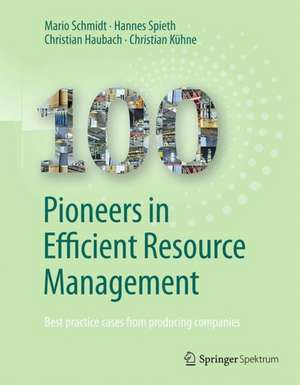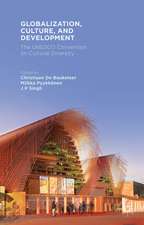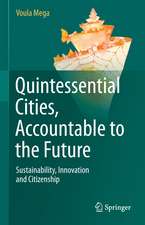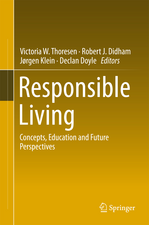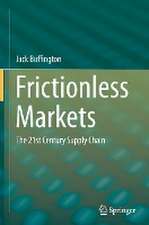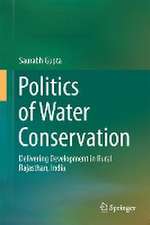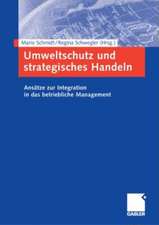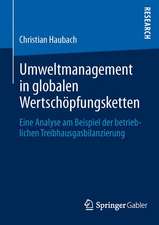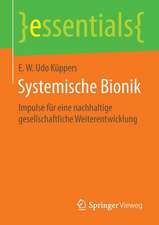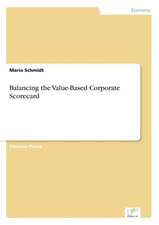100 Pioneers in Efficient Resource Management: Best practice cases from producing companies
Autor Mario Schmidt Editat de Institute for Industrial Ecology INEC Autor Hannes Spieth, Christian Haubach, Christian Kühneen Limba Engleză Hardback – 17 dec 2018
Baden-Wuerttemberg are showing their solutions. The project was carried out by a competent team from the Pforzheim University and the State Agency for Environmental Technology. Leading trade associations in Baden-Württemberg have supported it.
Preț: 632.28 lei
Preț vechi: 780.59 lei
-19% Nou
Puncte Express: 948
Preț estimativ în valută:
121.00€ • 125.86$ • 99.89£
121.00€ • 125.86$ • 99.89£
Carte tipărită la comandă
Livrare economică 10-16 aprilie
Preluare comenzi: 021 569.72.76
Specificații
ISBN-13: 9783662567449
ISBN-10: 366256744X
Pagini: 530
Ilustrații: XXIV, 530 p. 600 illus. in color.
Dimensiuni: 210 x 279 x 30 mm
Ediția:1st ed. 2019
Editura: Springer Berlin, Heidelberg
Colecția Springer Spektrum
Locul publicării:Berlin, Heidelberg, Germany
ISBN-10: 366256744X
Pagini: 530
Ilustrații: XXIV, 530 p. 600 illus. in color.
Dimensiuni: 210 x 279 x 30 mm
Ediția:1st ed. 2019
Editura: Springer Berlin, Heidelberg
Colecția Springer Spektrum
Locul publicării:Berlin, Heidelberg, Germany
Cuprins
Introduction: Communicate about resource efficiency.- PART I - Introduction to the topic.- 1 Resource efficiency in the industrial society.- 2 approaches to operational resource efficiency.- 3 Methods and tools.- 4 Resource efficiency as an export product.- 5 The 100-company project.- PART II - Examples of companies.- Mining and quarrying.- Food industry.- Textile industry.- Wood industry.- Paper industry.- Chemical industry.- Pharmaceutical industry.- Rubber and plastics industry.- Manufacture of glass and ceramics.- Metal processing industry.- Precision mechanical industry.- Manufacture of measuring and control instruments.- Electrical industry.- Mechanical engineering.- Automotive industry.- Furniture industry.- Medical technology.- Energy supply.- Recycling industry.- Construction industry.- Appendix.
Notă biografică
Prof. Dr. Mario Schmidt und Dr. Christian Haubach, beide Institut für Industrial Ecology (INEC), Hochschule Pforzheim; Dr. Hannes Spieth und Dr. Joa Bauer, beide Technologie- und Innovationszentrum Umwelttechnik und Ressourceneffizienz Baden-Württemberg GmbH, Böblingen
Textul de pe ultima copertă
The book presents about 100 current examples of how energy and materials can be saved in manufacturing companies. They serve to show which measures can be used in modern companies to exploit the potential for resource efficiency. The book is aimed at practitioners in companies and consulting firms, but is also suitable for the university sector as a practical introduction to the topic of resource efficiency. The materials used account for almost 43 percent of the costs of an average industrial company in Germany. Personnel costs, on the other hand, are only 22 percent, while energy costs are as low as 2 percent. If a company wants to save costs, above all it must consider the use of materials and produce in a resource-efficient manner. This simultaneously relieves the environment and reduces dependence on scarce raw materials. The implementation of resource efficiency is not easy. There are indeed numerous starting points in production, often in process innovations or in product development. However, only a few companies publish their measures and savings potentials. In practice, this means that there are often no learning examples in practice, but some of them are explicitly listed in this work. As you can see, resource efficiency in production and products can also be seen as a success factor for many companies. In the project 100 Pioneers in Efficient Resource Management, committed companies from
Baden-Wuerttemberg are showing their solutions. The project was carried out by a competent team from the Pforzheim University and the State Agency for Environmental Technology. Leading trade associations in Baden-Württemberg have supported it.
"With the examples presented on the topic of resource efficiency at company level, you are taking up a central topic of the future which, in view of the current challenges of climate and environmental protection, will require all of us to make even greater efforts in the future than before.”
Dr. Heinrich Bottermann, former Secretary General of the Deutsche Bundesstiftung Umwelt, since 30 June 2017 State Secretary at the Ministry of the Environment, Agriculture, Nature and Consumer Protection of North Rhine-Westphalia
"The practical examples presented illustrate the measures that companies can take to operate more efficiently in terms of energy and materials. I am confident that many small and medium-sized enterprises will benefit significantly from this report and thus make an important contribution to sustainable development".
Prof. Dr. Maximilian Gege, Chairman of the Federal German Working Group for Environmentally Conscious Management (B.A.U.M.)
"Practically all industries are represented, even including a goat cheese dairy. But also the big ones in the country are not missing. I was very pleased that the business associations and politicians supported the project. I can only warmly congratulate those involved."
Prof. Dr. Ernst Ulrich von Weizsäcker, Co-President of the Club of Rome, former Co-Chairman of the International Resource Panel
Baden-Wuerttemberg are showing their solutions. The project was carried out by a competent team from the Pforzheim University and the State Agency for Environmental Technology. Leading trade associations in Baden-Württemberg have supported it.
"With the examples presented on the topic of resource efficiency at company level, you are taking up a central topic of the future which, in view of the current challenges of climate and environmental protection, will require all of us to make even greater efforts in the future than before.”
Dr. Heinrich Bottermann, former Secretary General of the Deutsche Bundesstiftung Umwelt, since 30 June 2017 State Secretary at the Ministry of the Environment, Agriculture, Nature and Consumer Protection of North Rhine-Westphalia
"The practical examples presented illustrate the measures that companies can take to operate more efficiently in terms of energy and materials. I am confident that many small and medium-sized enterprises will benefit significantly from this report and thus make an important contribution to sustainable development".
Prof. Dr. Maximilian Gege, Chairman of the Federal German Working Group for Environmentally Conscious Management (B.A.U.M.)
"Practically all industries are represented, even including a goat cheese dairy. But also the big ones in the country are not missing. I was very pleased that the business associations and politicians supported the project. I can only warmly congratulate those involved."
Prof. Dr. Ernst Ulrich von Weizsäcker, Co-President of the Club of Rome, former Co-Chairman of the International Resource Panel
Caracteristici
Possible ways to save energy and materials Resource efficiency demonstrated by examples of manufacturing companies Illustrative, illustrated in colour, hands-on experience
